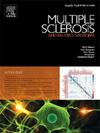与多发性硬化症无关的自身免疫性视神经炎患者的生物标志物:人口统计学、临床和预后特征
IF 2.9
3区 医学
Q2 CLINICAL NEUROLOGY
引用次数: 0
摘要
背景:新的视神经炎(ON)分类导致了ON患者分组方式的改变。我们的目的是评估与多发性硬化症无关的自身免疫性ON患者的临床特征和预后。方法:转到我们神经眼科实验室的患者被纳入这项回顾性研究。排除伴有多发性硬化症的ON患者。其余患者分为3组:水通道蛋白-4 (AQP4)抗体ON组、髓鞘少突胶质细胞糖蛋白(MOG)抗体ON组和血清ON阴性组。患者在入院时、急性治疗后一个月和第三年随访时接受检查。我们比较了这三组的人口学、临床、放射学、实验室数据和治疗反应。结果:纳入92例患者。AQP-ON和MOG-ON组发病年龄较大、同时累及双侧视神经、发病时视力严重丧失、需要积极治疗的发生率均高于血清ON阴性组(P = 0.01, P = 0.003, P = 0.011, P = 0.007, P < 0.001, P < 0.001)。视盘水肿的存在是MOG-ON的显著特征,MRI上长时间对比增强(P = 0.003, P = 0.002)。AQP4-ON患者的特点是有额外的自身免疫抗体和视神经外的中枢神经系统病变(P < 0.001, P = 0.015)。广义估计方程分析显示,AQP4抗体的存在、年龄的增加和复发率与视力随时间的变化相关(P = 0.014, P = 0.002, P = 0.016)。结论:血清生物标志物状态与人口统计学、临床特征和视觉结果的关联表明,生物标志物检测在这些患者中的重要性。本文章由计算机程序翻译,如有差异,请以英文原文为准。
Biomarkers in patients with autoimmune optic neuritis not associated with multiple sclerosis: Demographic, clinical and prognostic features
Background
The new optic neuritis (ON) classification leads to a change in how ON patients are grouped. Our aim is to appraise the clinical features and prognoses of patients with autoimmune ON not associated with MS. Methods: Patients referred to our neuro-ophthalmology laboratory were enrolled to this retrospective study. Patients with ON associated with MS were excluded. The remaining patients were divided into three groups: aqauaporin-4 (AQP4) antibody ON group, myelin oligodendrocyte glycoprotein (MOG) antibody ON group, and seronegative ON group. The patients were examined on admission, one month after acute treatment, and at the third-year follow-up. We compared demographic, clinical, radiologic, laboratory data, and treatment responses among these three groups.
Results
The study included 92 patients. The older age of onset, bilateral simultaneous involvement of the optic nerves, severe vision loss at onset, and need for aggressive treatment were more common in the AQP-ON and the MOG-ON groups than the seronegative ON group (P = 0.01, P = 0.003, P = 0.011, P = 0.007, P < 0.001, P < 0.001, respectively). The presence of optic disc edema was a significant feature of MOG-ON as well as long-length contrast enhancement on MRI (P = 0.003, P = 0.002). Additional autoimmune antibodies and CNS lesions outside the optic nerve were the features of AQP4-ON patients (P < 0.001, P = 0.015). Generalized estimating equations analysis revealed that the presence of AQP4 antibody, increased age and recurrence were associated with visual acuity over time (P = 0.014, P = 0.002, P = 0.016, respectively).
Conclusion
The association of serum biomarker status with demographic, clinical features, and visual outcomes indicate the importance of biomarker detection in these patients.
求助全文
通过发布文献求助,成功后即可免费获取论文全文。
去求助
来源期刊

Multiple sclerosis and related disorders
CLINICAL NEUROLOGY-
CiteScore
5.80
自引率
20.00%
发文量
814
审稿时长
66 days
期刊介绍:
Multiple Sclerosis is an area of ever expanding research and escalating publications. Multiple Sclerosis and Related Disorders is a wide ranging international journal supported by key researchers from all neuroscience domains that focus on MS and associated disease of the central nervous system. The primary aim of this new journal is the rapid publication of high quality original research in the field. Important secondary aims will be timely updates and editorials on important scientific and clinical care advances, controversies in the field, and invited opinion articles from current thought leaders on topical issues. One section of the journal will focus on teaching, written to enhance the practice of community and academic neurologists involved in the care of MS patients. Summaries of key articles written for a lay audience will be provided as an on-line resource.
A team of four chief editors is supported by leading section editors who will commission and appraise original and review articles concerning: clinical neurology, neuroimaging, neuropathology, neuroepidemiology, therapeutics, genetics / transcriptomics, experimental models, neuroimmunology, biomarkers, neuropsychology, neurorehabilitation, measurement scales, teaching, neuroethics and lay communication.
 求助内容:
求助内容: 应助结果提醒方式:
应助结果提醒方式:


